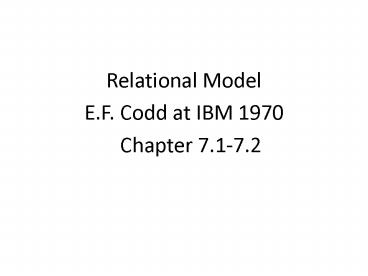Relational Model - PowerPoint PPT Presentation
1 / 14
Title:
Relational Model
Description:
Glossary of terms: Table - RELATION. Row - TUPLE ... Glossary Cont'd. DOMAIN D. specify data type, format for each domain. is of data-type (or format) ... – PowerPoint PPT presentation
Number of Views:255
Avg rating:3.0/5.0
Title: Relational Model
1
- Relational Model
- E.F. Codd at IBM 1970
- Chapter 7.1-7.2
2
Relational Model
- Most popular
- simplest
- most uniform data structures
- most formal
- files mathematical foundation
3
Relational Model
- database is a collection of relations
- relation is a table of values
- a table is composed of rows and columns
- row - a collection of related data values
- describing an entity or relationship instance
- column same attribute for different entities
4
Glossary of terms
- Table -gt RELATION
- Row -gt TUPLE
- Column header -gt ATTRIBUTE
- Data type of a column -gt DOMAIN
- Fig. 7.1
5
Glossary Contd
- DOMAIN D
- specify data type, format for each domain
- is of data-type (or format)
- set of atomic values (relational model
requirement) - TUPLE
- no composite values (all values are atomic)
- no multivalued attributes (First Normal Form)
6
Relations
- RELATION Characteristics
- Set of tuples - not ordered
- Values within tuples are ordered
- ATTRIBUTES
- Ai is an attribute with a domain dom(Ai)
- degree of a relation - the number of attributes
- RELATION SCHEMA R(A1, A2,...,An)
- includes relation name R and list (set) of
attributes Ai - Fig 7.5
7
Relations
- RELATION (instance) r( R )
- current relation state
- set of n-tuples (where n is a number of
attributes) - r t1, t2,...,tm each n-tuple t is an ordered
list on n values - t ltv1, v2,...vngt where vi is an element of
dom(Ai) or null - t1Ai is the value vi for attribute Ai of
tuple t1 - r( R ) is a subset of dom(A1) X dom(A2) X...X
dom(An) - the tuples themselves are not ordered
8
Relations
- relation intension refers to the schema
- relation extension to the state
- all tuples within a relation are distinct
- Fig 7.6
9
Constraints
- DOMAIN CONSTRAINTS
- 1st normal form 1NF
- value of each attribute must be an atomic
(single) value from the domain for that attribute
- no composite attributes
10
Constraints
- 2. KEY CONSTRAINTS
- All elements are distinct
- no two tuples can have the same combination of
values for all their values (uniqueness
constraint). Therefore, all elements are
distinct. - superkey sk
- any set of attributes with property
- no two tuples from the relation have the same
combination of values for those attributes - t1sk ! t2sk
- every relation has at least one superkey, what
is it?
11
Constraints contd
- key is a minimal superkey if
- we cannot remove any attribute and still have
uniqueness constraint hold - candidate key is any one of the keys
- primary key PK is designated candidate key
(underlined)
12
Constraints
- 3. ENTITY INTEGRITY CONSTRAINTS
- no primary key value can be null
13
Constraints
- 4. REFERENTIAL INTEGRITY CONSTRAINTS
- a tuple in one relation that refers to another
relation must refer to an existing tuple in that
relation - specified between two relations
- maintain the consistency among tuples in two
relations - if one relation refers another, then the primary
key of the referred relation is a foreign key FK
in the referring relation. - t1PK t2FK
- Fig 7.7
14
Relations
- RELATIONAL DATABASE SCHEMA
- a set of relation schemas and a set of
referential integrity constraints - S R1, R2,..., Rm and a set of integrity
constraints IC - RELATIONAL DATABASE INSTANCE DB
- DB r1, r2,...rm































